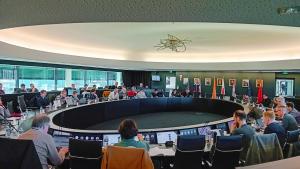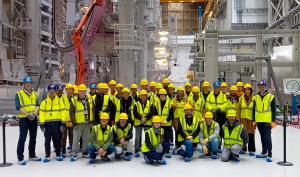Collaborating to advance tokamak integrated modelling
Present-day tokamak integrated modelling development activities put significant emphasis on the development of high-fidelity physics models to extrapolate physics understanding obtained from current experiments to future devices, on integration of the validated physics models into workflows, and on the application of automated larger-scale validation. In this context, the third meeting of Advances in Tokamak Integrated Modelling (ATIM), jointly organized by EUROfusion's TSVV11 (Theory, Simulation, Validation and Verification) task and the Dutch eScience Centre (Large-scale Validation and Uncertainty Quantification), took place at ITER Organization headquarters from 22 to 26 January 2024. The main aims of this meeting were to share recent advances in the area of tokamak integrated modelling and to align activities with ITER's integrated modelling development needs.
Advanced predictive modelling of plasma operation scenarios will be required in ITER and future tokamaks not only to prepare their research plans with detailed experimental campaigns, but also to support the design and validation of tokamak components and controls, and to analyze plasma discharges obtained during experimentation. These modelling-oriented activities require validated physics models covering a wide range of physics fidelity—from fast empirical or surrogate models for control applications to high-fidelity physics models for detailed analysis. These validated models are integrated into robust modelling workflows designed to address specific use cases without loss of physics fidelity. Large-scale automated validation and uncertainty quantification (UQ) can significantly facilitate the validation of both stand-alone physics models and integrated modelling workflows, providing the ranges of validity and/or uncertainties. Recent advances in artificial intelligence (AI) can also contribute to the development of the surrogate models necessary to develop fast-plasma pulse design software and plasma control algorithms suitable for real-time application. A new Persistent Actor Framework (based upon the MUSCLE3 Multiscale Coupling Library and Environment) implemented within ITER's Integrated Modelling & Analysis Suite (IMAS) is enabling co-simulations across different software environments. All these advanced developments not only support ITER integrated modelling priorities, but also those of existing and future devices.
To share recent advances in the tokamak integrated modelling area and to align various activities with ITER's integrated modelling development needs, the third in-person meeting of Advances in Tokamak Integrated Modelling (ATIM), jointly organized by EUROfusion's TSVV11 (Theory, Simulation, Validation and Verification) task and the Dutch eScience Centre (Large-scale Validation and Uncertainty Quantification), was hosted at ITER Organization headquarters from 22 to 26 January 2024. More than 50 participants, including many young modellers and scientists, took part. The meeting was organized to start with plenary sessions providing reports on recent progress and plans, and then continued with multiple parallel sessions designed to directly exchange technical expertise and information. Multiple trainings on the large-scale automated validation tool (dUQtools), IMASpy, and the iWrap actor generation tool were also provided respectively by the Dutch eScience Center and the Ignition Computing and Poznan Supercomputing and Networking Center to support ITER Integrated Modelling and Analysis Suite (IMAS) development within the ITER Members.
Various advances in the high-fidelity integrated modelling platforms used throughout Europe (JINTRAC, ETS and ASTRA) were discussed to support the development of ITER's high-fidelity plasma simulator (HFPS), which is also currently based on JINTRAC (core-edge-SOL-divertor/wall transport and source modelling) in combination with DINA (free-boundary plasma equilibrium evolution). Topics covered the modelling platforms, current ramp-up modelling for validation, tungsten impurity transport modelling and prediction, and further improvements of core transport and pedestal/scrap-off-layer models. Fast-pulse design and optimization tools, including the ITER pulse design simulator (PDS), were also presented to share their status and plans.
The next steps are foreseen to include further validation of physics models including multi-physics components (MHD, impurity, rotation, pedestal, etc.), improvement of physics modelling workflows (with modular and exchangeable components) and systematic validation against larger experimental databases, aligned with ITER's integrated modelling development needs.



